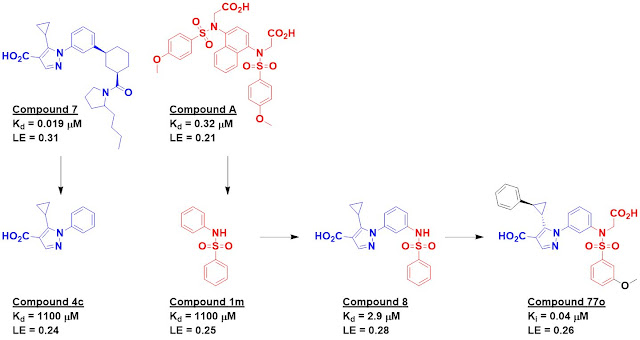Over the past sixteen months SARS-CoV-2
has infected more than 146 million people worldwide and killed over 3 million. Highly
effective vaccines are now available, but not everywhere, and how long the
vaccinations will last as new variants arise remains unknown. COVID-19 will
likely be with us indefinitely, necessitating drugs as well as vaccines.
More than a year ago we highlighted
the COVID Moonshot effort, which began with a crystallographic screen against the
essential main protease (Mpro) to find starting points for drug discovery.
In a new open-access J. Biomol. NMR paper, Ioannis Vakonakis and collaborators
at University of Oxford and University of Patras have attempted to characterize
some of the hits using saturation transfer difference NMR (STD NMR, see here
for a brief description).
The researchers had access to a
950 MHz NMR (jealous much?). Samples were screened at 10 µM protein using
irradiation of a Mpro methyl group with a chemical shift at 0.5 ppm.
To try to minimize differences in relaxation parameters among different ligands,
only the strongest STD signals in aromatic moieties were examined.
Of 39 non-covalent ligands
discovered in the crystallographic screen, five either did not produce an NMR signal or
the spectra were inconsistent with the expected structures, suggesting the
ligands may be insoluble or unstable in aqueous buffer. The remaining 34
compounds were nominally screened at 0.8 mM each, but the reference spectra differed
in intensity by as much as 15-fold, suggesting dramatic differences in
concentration. Since the strength of an STD signal is related to both affinity
and concentration, this could obviously complicate interpretation of results. As
we’ve written previously, careful curation of your library is essential.
Of thirteen active site ligands,
only four showed strong STD signals. Dose-response titrations between 0.05 and 4
mM revealed dissociation constants of 1.6-1.7 mM for two of them, with the
other two being too weak to accurately measure. Molecular dynamics simulations starting
with the known structures were consistent with these results, with the tighter
binders tending to maintain their positions more than the weaker binders.
The researchers also characterized
650 elaborated molecules from the COVID Moonshot, some of which had been
reported to be nanomolar inhibitors. Disturbingly, 35 gave
no NMR signal and another 86 yielded weak signals. Among those remaining there
was a weak correlation (R2=30%) between IC50 in an enzymatic
assay and the STDratio (integrated signal intensity of peaks in the
STD spectrum over reference spectrum). STD NMR is not appropriate for molecules
with Kd < 10 µM, so the researchers also used a competition experiment
in which four putative high-affinity molecules would compete a weaker “spy” fragment.
This exercise confirmed two ligands but not two others, calling into question
their mechanism.
STD NMR is often used as part of
an assay cascade prior to attempting crystallography, but as crystallography
throughput increases there is a case for starting with crystallography, as we
argued five years ago. Results from the 39 crystallographic hits perhaps gives
pause to that notion, or at least emphasize the need for confirmatory assays. It
is easy to be seduced by a high-resolution structure, but because of its sensitivity
crystallography may identify ligands so weak as to be unadvanceable. As for the
650 elaborated molecules, it’s too early to draw conclusions, though it’s good
to always be on the lookout for false positives.
Hopefully the COVID Moonshot will
ultimately lead to drugs against SARS-CoV-2. But even if it doesn’t, the
intensive focus of multiple techniques on a few proteins is providing useful
guidance and best practices that will be applicable to other targets.





